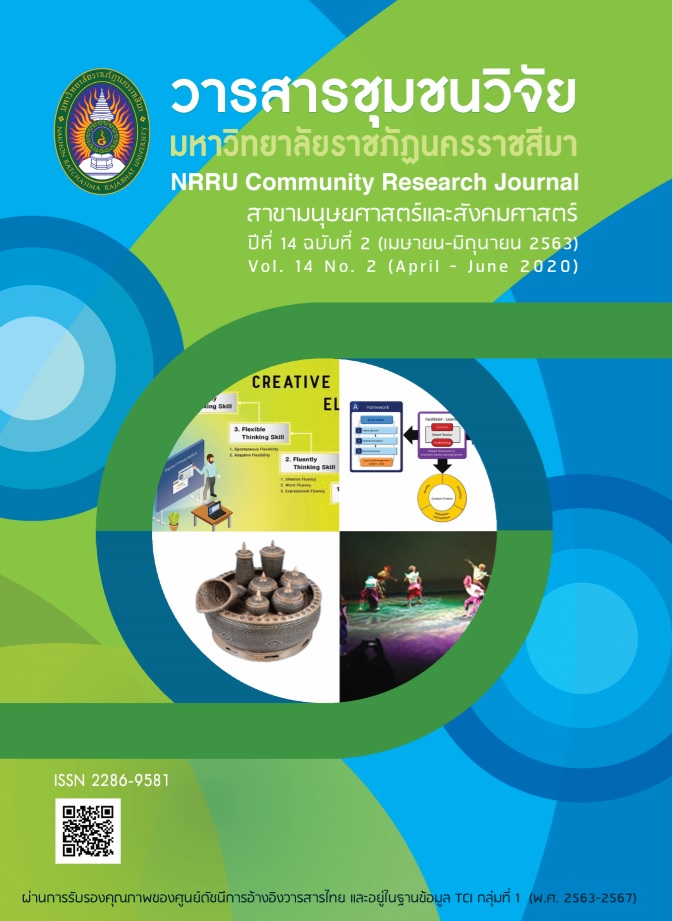CONFIRMATORY FACTOR ANALYSIS OF COLLEGE STUDENTS’ MEANING IN LIFE
การวิเคราะห์องค์ประกอบเชิงยืนยันความหมายในชีวิตของนักศึกษาครู
DOI:
https://doi.org/10.14456/nrru-rdi.2020.22Keywords:
Meaning in life of college students, Confirmatory factors analysis, Teacher studentsAbstract
The purposes of this study were to study of the confirmatory of meaning in life model of college students and to study of meaning in life of college students. The samples were 917 students who enrolled in the Education Faculty in Rajabhat University in academic year 2018. The samples received by multistage random sampling. The instrument use in this research was a College Students’ Meaning in Life Scale. The reliability of the test was .905. The statistic used to analyze data comprising of frequency, percentage, mean, standard deviation and confirmatory factor analysis.
The research result were :
The first order of the confirmatory factor analysis of meaning in life of college students consisted of 9 observed variables. The result found that factor loading between 0.44-0.84 at 0.01 level. And goodness of fit with the empirical data were X²=6.46, P-Value=0.78, X2/df=0.64, GFA=1.00, GFAI=0.99, CFI=1.00, RMR=0.00, and RMSEA=0.00 respectively. And the results the model analysis of the second confirmatory factor found that the meaning in life of the three components have factor loading between 0.78-1.00 while shown that the model has goodness of fit with the empirical data. The result shown that Meaning in Life of Students College’ scores is high level. ( =3.78, SD=0.38).
References
Battista, J., & Almond, R. (1973). The development of meaning in life. Psychiatry, 36, 409-427.
Baumeister, R. F., Vohs, K. D., Aaker, J. L., & Garbinsky, E. N. (2013). Some key differences between a happy life and a meaningful life. The Journal of Positive Psychology, 8(6), 505–516.
Bonebright, C. A., Clay, D. L., & Ankenmann, R. D. (2000). The relationship of workaholism with work-life conflict, satisfaction, and purpose in life. Journal of Counseling Psychology, 47, 469-477.
Brassai, L., Piko, B. F., & Steger, M. F. (2011). Meaning in life: Is it a protective factor for adolescents’ psychological health? International Journal of Behavioral Medicine, 18, 44–51.
Chamberlain, K. & Zika, S. (1988). Religiosity, life meaning, and well-being. Some relationships in a sample of women. Journal for the Scientific Study of Religion, 27, 411-420.
Costello, A. B., & Osborne, J. W. (2005). Best practices in exploratory factor analysis: Four recommendations for getting the most from your analysis. Practical Assessment, Research and Evaluation, 10(7), 1-9.
Debats, D. L., Van der Lubbe, P. M., & Wezeman, F. R. (1993). On the psychometric properties of the LifeRegard Index (LRI): A measure of meaningful life. Personality and Individual Differences, 14(2), 337-345.
Frankl, V. E. (1965). The will to meaning: Foundations and Applications of Logotherapy. Lodon : Plume Book.
Halama, P., & Medova, M. (2007). Meaning in life and hope as predictors of positive mental health: do they explain residual variance not predicted by personality trait? Study Psychology, 49, 191-200.
Harlow, L. L., Newcomb, M. D., & Bentler, P. M. (1986). Depression, self-derogation, substance use, and suicide ideation: Lack of purpose in life as a mediational factor. Journal of Clinical Psychology, 42, 5-21.
Heintzelman, S. J., & King, L. A. (2014). Life is pretty meaningful. American Psychologist, 69, 561-574.
Hicks, J. A., & King, L. A. (2007). Meaning in life and seeing the big picture: positive affect and global focus. Cognition Emotion Journal, 21, 77-84.
Ho, M. Y., Cheung, F. M., & Cheung, S. F. (2008). Personality and life events as predictors of adolescents’ life satisfaction: Do life events mediate the link between personality and life satisfaction?. Social Indicators Research, 89, 457-471.
Jöreskog, K. G., & Sörbom, D. (1999). LISREL 8:User's Reference Guide. Skokie, IL : Scientific Software International.
Martela, F., & Steger, M. F. (2016). The Three Meanings of Meaning in Life: Distinguishing Coherence, Purpose, and Significance. The Journal of Positive Psychology, 11(5), 531-545.
Morgan, J., & Farsides, T. (2009). Measuring meaning in life. Journal of Happiness Studies, 10, 197-214.
Nielsen, A. M., & Hansson, K. (2007). Association between adolescents' health, stress and sense of coherence. Stress and Health (Print), 23(5), 331-341.
Office of the Higher Education Commission. (2018). Data of Number of Rajabhat University Students inAcademic Year 2017. Retrieved January, 23, 2018, from http://www.info. mua.go.th/ information/index.php/ (in Thai)
Rathi, N., & Rastogi, R. (2007). Meaning in life and psychological well-being in pre-adolescents and adolescents. The Journal of the Indian Academy of Applied Psychology, 33, 31-38.
Reker, G., & Wong, P. (2012). Aging as an individual process: Toward a theory of personal meaning. In J. Birren & V. Bengston (Eds.), Emergent theories of Aging (pp 214-256). New York : Springe.
Sharf, R. S. (2016). Theories of Psychotherapy and Counseling: Concepts and Cases. Boston, MA : Cengage Learning.
Siahpush, M., Spittal, M., & Singh, G. (2008). Happiness and Life Satisfaction Prospectively Predict Self-Rated Health, Physical Health, and the Presence of Limiting, Long-Term Health Conditions. American Journal of Heath Promotion, 23(1), 18-26.
Simonsson, B., Nilsson, K. W., Leppert, J., & Diwan, V. K. (2008). Psychosomatic complaints and sense of coherenceamong adolescents in a county in Sweden: A cross-sectional school survey. Biopsychosoc Med, 2(4), 1-8.
Steger, M. F. (2012). Making meaning in life. Psychological Inquiry, 23, 381-385.
Steger, M. F., & Kashdan, T. B. (2007). Stability and specificity of meaning in life and life satisfaction over one year. Journal of Happiness Studies: An Interdisciplinary Forum on Subjective Well-Being, 8(2), 161-179.
Steger, M. F., Frazier, P., Oishi, S., & Kaler, M. (2006). The meaning in life questionnaire: Assessing the presence of and search for meaning in life. Journal of Counseling Psychology, 53, 80-93.
Tuicomepee, A. (2010). Logotherapy. Bangkok : Chulalongkorn University Printing House. (In Thai)
Wiratchai, N. (1999). LISREL Model: Statistical Analysis for Research (3rd ed.). Bangkok : Chulalongkorn University Printing House. (in Thai)
Zika, S., & Chamberlain, K. (1992). On the Relation Meaning in Life and Psychological Well-Being. British Journal of Psychology, 83, 133-145.




